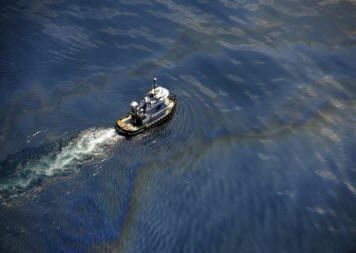Training: Aerial Observation of Oil Spills
An important step in oil spill response is assessing the appearance and distribution of oil spilled on the water. This information is used by the Incident Command to prioritize the response and to direct cleanup resources. We offer several levels of training in the aerial observation of oil on water:
1. Online Introduction for Coast Guard Aircrews
The Office of Response and Restoration's Emergency Response Division has partnered with The COMET® Program to develop a training module designed specifically for U.S. Coast Guard aircrews.
This online training provides a basic one-hour introduction to aerial (overflight) observation of oil on water. Although designed for Coast Guard aircrews, who may spot oil spills in the course of their work, other flight crew members may find this lesson useful, including those from Incident Management Divisions or the Coast Guard Auxiliary, commercial aircrews, and private pilots.
Take the online training: Introduction to Observing Oil from Helicopters and Planes (You'll need to create a username and password)
To assist aircrews who have completed the online training, we've created an Oil Observation Checklist. You can use this checklist to record oil slick characteristics and on-scene conditions from an overflight observation, using terminology that's most useful to oil spill responders.
Download the Checklist: Oil Observation Checklist [PDF, 400 KB]
2. Overview for Spill Responders
OR&R's Science of Oil Spills (SOS) classes include an overview of aerial observation during oil spill response. Learn more about SOS classes, and when and where the next class is scheduled.
3. Comprehensive Training for Spill Responders
To learn when and where OR&R's 1-day aerial observation training will be offered in your area, contact the Scientific Support Coordinator (SSC) for your region.
More Information about Aerial Observation
Job Aid for Aerial Observation: The Open Water Oil Identification Job Aid for Aerial Observation helps spill responders perform efficient aerial assessments of oil and use standard language to communicate their findings effectively.
A Case of Mistaken Identity: Can You Spot the False Oil Positives? Read a blog post that features photos of different kinds of oil, as well as some things commonly confused with spilled oil.
Questions: Contact us with any questions about aerial observation training.
 An official website of the United States government.
An official website of the United States government. 
